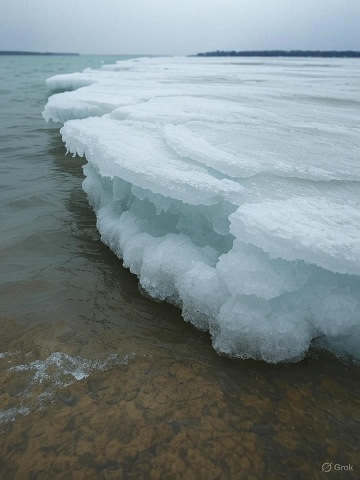Lake Michigan’s unstable shelf ice poses risks that many people still don’t fully understand. Every winter, the lake freezes in parts, forming large, thick-looking chunks of ice. While these icy ledges may look solid and fun to walk on, they are extremely dangerous. Let’s take a closer look at why this happens, how it affects people, and how to stay safe.
Contents
What Is Shelf Ice on Lake Michigan?
Shelf ice is a large formation of ice that builds up along the shorelines of Lake Michigan during winter. Wind, waves, and freezing temperatures push slushy water together until it forms icy platforms. These ice shelves may stretch far into the lake and appear strong—but they are full of hidden cracks, thin spots, and air pockets.
Real-Life Example:
In February 2020, two teenagers fell through shelf ice near Waukegan, Illinois. While one was rescued quickly, the other was trapped and sadly drowned. The rescue teams struggled to move on the unstable surface, delaying the rescue. This tragedy shows how dangerous shelf ice can be—even for people just exploring nearby.
Why Lake Michigan’s Unstable Shelf Ice Poses Risks
Even when shelf ice looks solid, it often isn’t. Here are key reasons why shelf ice is dangerous:
| Risk | Explanation |
|---|
| Hidden Cracks | Ice forms unevenly, creating invisible weak spots that can break easily. |
| Air Pockets and Gaps | Ice forms over open water, with spaces underneath where someone can fall in. |
| Moving Water Beneath | The lake doesn’t freeze all the way—strong currents continue under the ice. |
| Disorientation After a Fall | Falling through ice can cause panic and disorientation, making rescue hard. |
| Delayed Rescue Time | Ice makes it hard for emergency crews to reach victims quickly. |
How Shelf Ice Forms on the Great Lakes
Shelf ice forms during cold, windy weather. Here’s how:
- Cold air causes lake water to form slush near the shore.
- Waves and wind pile the slush into chunks.
- These chunks freeze together and grow larger over time.
- The process repeats, creating thick but uneven ice shelves.
Even though the top layer might seem sturdy, the ice underneath may be thin or not connected.
Shelf Ice Accidents and Case Studies
Case Study 1: Holland State Park Incident (2021)
Three adults walked onto shelf ice while taking photos. One slipped through a weak spot. The other two tried to help but also fell in. Emergency teams pulled all three out, but one suffered from severe hypothermia.
What Went Wrong:
They didn’t realize the shelf was over open water and had no safety gear.
Case Study 2: Sleeping Bear Dunes Warning (2019)
Rangers spotted hikers 300 feet out on shelf ice. Rangers used loudspeakers to call them back. Luckily, no one was hurt—but the area they walked on collapsed hours later.
Lesson Learned:
Just because shelf ice holds for a few minutes doesn’t mean it’s safe.
Advantages and Disadvantages of Shelf Ice
| Advantages | Disadvantages |
|---|
| Natural winter beauty | Creates dangerous illusion of safety |
| Protects shoreline from wave erosion | Hard to tell how thick or stable it really is |
| Habitat for winter birds | Can trap people who venture too far |
| Fun for photography—from a distance | Delays emergency response in case of fall-through accidents |
How to Stay Safe Around Lake Michigan Shelf Ice
To avoid danger, follow these safety tips:
✅ Do This:
- Stay off shelf ice entirely—don’t walk, sled, or fish on it
- Use binoculars or zoom lenses for winter photography
- Watch from safe, designated areas like boardwalks or dunes
- Teach kids about ice safety early
- Heed posted warning signs and weather alerts
- Dress warmly and carry a phone in a waterproof case in case of emergency
❌ Avoid This:
- Never assume the ice is strong enough to hold your weight
- Don’t follow footprints—the person before you may have gotten lucky
- Don’t take pets or children onto shelf ice
- Don’t ignore rescue crews’ warnings or alarms
External Resource: Learn more safety tips from the U.S. Coast Guard on Great Lakes Winter Safety.
How Authorities Are Spreading Awareness
Many local groups are working hard to keep people safe during winter along Lake Michigan:
- National Park Service shares warning signs and photos
- Local fire departments post video messages about ice dangers
- School programs teach ice safety to students in shoreline towns
- Social media campaigns alert the public when shelf ice becomes dangerous
The goal is to reduce tragic accidents by helping people understand that Lake Michigan’s unstable shelf ice poses risks, even for experienced winter explorers.

FAQs About Lake Michigan’s Unstable Shelf Ice Poses Risks
Q1: Can you walk on shelf ice if it looks thick?
A: No. Even thick-looking shelf ice can be hollow or resting on weak spots. It can break anytime.
Q2: Is all shelf ice unsafe?
A: Yes. Shelf ice is unstable by nature. You should never walk on it.
Q3: What should I do if someone falls through?
A: Call 911 immediately. Do not attempt to rescue them yourself. Stay back and wait for emergency crews.
Q4: Is it okay to walk near shelf ice?
A: Only if you’re on a safe path or overlook. Avoid getting close to the edge.
Q5: Why doesn’t the lake freeze solid like a pond?
A: Lake Michigan is massive and deep. The water under the ice is always moving, making it hard to freeze completely.
Conclusion
Lake Michigan’s unstable shelf ice poses risks that are real and life-threatening. While the icy edges may seem like an exciting place to explore or snap winter photos, the dangers below are invisible and unpredictable. Every year, people fall through and some never come back. By respecting warning signs, staying informed, and educating others, we can prevent more winter tragedies on the Great Lakes.
If you live near or visit Lake Michigan in winter, always remember: admire the ice—but from a safe distance.
Related Resources for Further Reading:
- NOAA Great Lakes Ice Conditions
- Michigan DNR Winter Ice Safety
- Chicago Tribune Coverage of Ice Incidents







